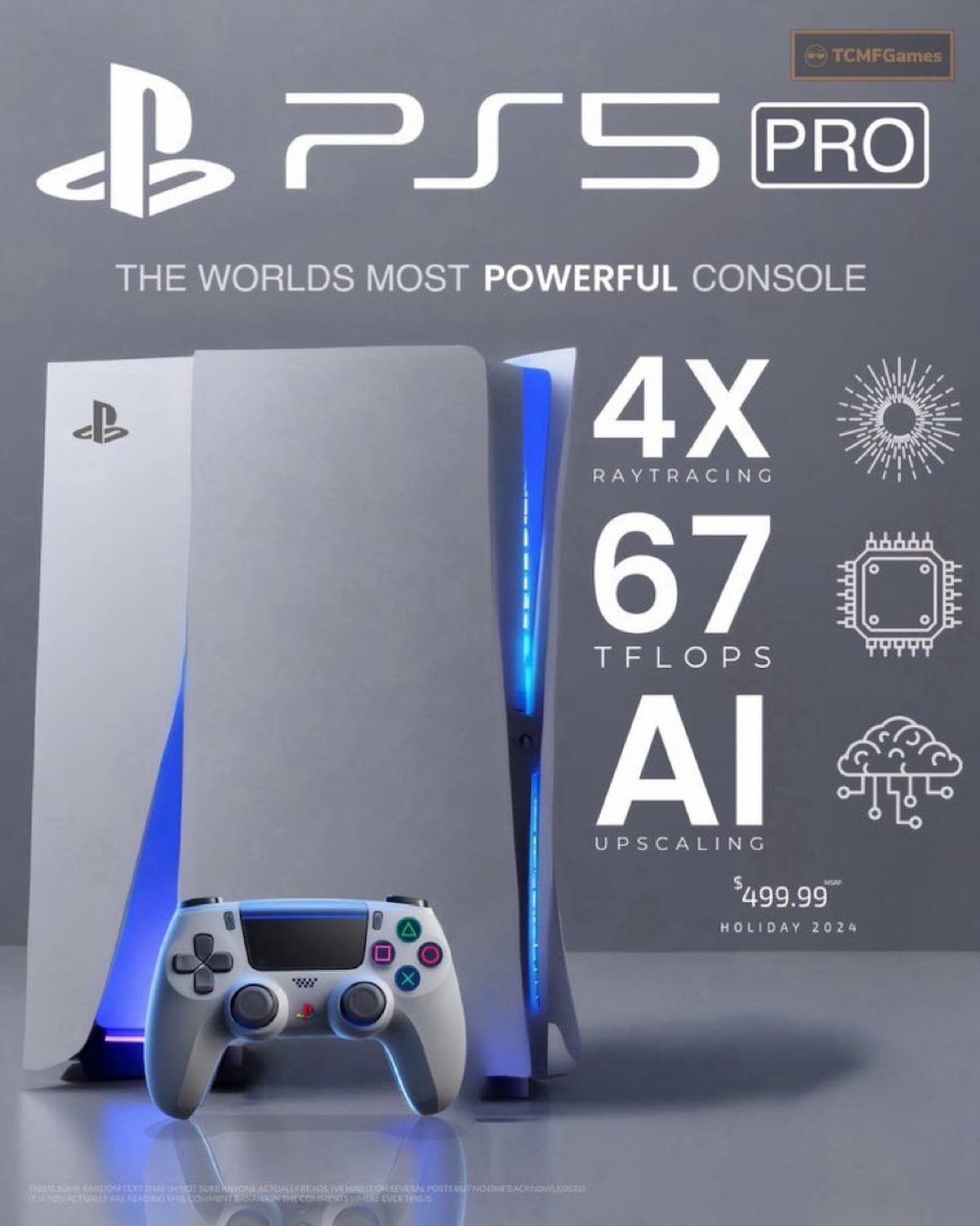Are you ready for the next level of gaming? Buckle up because the Sony PS5 Pro might just blow your mind with its latest feature: PSSR Spectral Super Resolution. But before you dive into the hype, let’s dissect what this all means and whether it’s worth the buzz.
Key Takeaways
- Sony teases the PS5 Pro with PSSR Spectral Super Resolution support.
- PSSR leverages machine learning for enhanced upscaling capabilities.
- The technology aims to deliver higher-resolution visuals with improved detail.
- Rumored PS5 Pro specs suggest significant upgrades in CPU, GPU, and memory.
Deciphering the Leaks: What is PSSR?
So, what’s all this fuss about PSSR? Well, it’s not just another acronym thrown around in the gaming world. PSSR stands for PlayStation Spectral Super Resolution, a cutting-edge technology purportedly integrated into the upcoming PS5 Pro console.
But what exactly does it do? PSSR harnesses the power of machine learning to upscale graphics, enhancing visual fidelity and detail. It’s like giving your games a makeover, making them look sharper and more immersive than ever before.
Unpacking the Technology: How Does PSSR Work?
At its core, PSSR operates on the principle of temporal upscaling. By analyzing data from previous frames, it intelligently extrapolates details to enhance the current frame. Think of it as a digital artist filling in the gaps to create a masterpiece.
But PSSR isn’t just another run-of-the-mill upscaling technique. It’s backed by machine learning algorithms, making it more adaptive and efficient. This means smoother transitions, crisper textures, and overall better visuals for gamers to feast their eyes on.
Comparing the Competition: PSSR vs. DLSS and FSR
In the realm of upscaling technologies, PSSR stands tall alongside its rivals: DLSS (Deep Learning Super Sampling) and FSR (FidelityFX Super Resolution). While DLSS and FSR have already made waves in the gaming community, PSSR aims to raise the bar even higher.
But how does PSSR stack up against the competition? Well, it’s all about the quality of the output. With machine learning at its core, PSSR promises unparalleled visual fidelity, rivaling—if not surpassing—the performance of DLSS and FSR.
The Road Ahead: What to Expect from the PS5 Pro
Excited about the prospects of the PS5 Pro? You’re not alone. With rumors swirling about its beefed-up specs, including a more potent CPU, GPU, and memory configuration, anticipation is reaching fever pitch.
While we eagerly await official confirmation from Sony, one thing’s for sure: the PS5 Pro with PSSR Spectral Super Resolution could revolutionize the gaming landscape, ushering in a new era of immersive visuals and unparalleled performance.
#PS5Pro Specs leaked – 45% faster rendering than base PS5 – Bigger GPU with faster system memory – 3x faster Ray Tracing – PlayStation Spectral Super Resolution upscaling – Custom machine learning architecture – 300 TOPS of 8-bit computation – 67 TFLOPs of 16-bit floating point
Certainly! Let’s create a comparison chart detailing the rumored specifications of the PS5 Pro, PS5, and Xbox Series X:
| Specification | PS5 Pro | PS5 | Xbox Series X |
|---|---|---|---|
| CPU | Increased clock speeds | Similar cores and threads | Similar to PS5 |
| GPU | 60 compute units | 36 compute units | Custom RDNA 2, 52 CUs @ 1.825 GHz |
| GPU Clock | Similar | Similar | Custom RDNA 2, 12 TFLOPS |
| Memory Configuration | Similar with increased memory bandwidth | Similar | 16GB GDDR6, 320-bit bus |
| Storage | – | – | 1TB NVMe SSD |
| Optical Drive | – | – | 4K UHD Blu-ray |
| Dimensions | – | – | 15.1 x 15.1 x 30.1 cm |
| Weight | – | – | 4.45 kg |
Please note that these specifications are based on rumors and leaked information, and the actual specifications may vary. It’s always best to wait for official confirmation from the respective manufacturers.
Absolutely, let’s delve into the exciting advancements in DLSS 3.5 Ray Reconstruction and Full Ray Tracing in gaming:
DLSS 3.5 Ray Reconstruction: Elevating Visual Fidelity
DLSS (Deep Learning Super Sampling) has been a game-changer in the realm of upscaling technology, and its latest iteration, DLSS 3.5, takes things up a notch with Ray Reconstruction. This innovative technique enhances visual fidelity by leveraging ray tracing to reconstruct scenes with unparalleled detail and realism.
Benefits of DLSS 3.5 Ray Reconstruction:
- Improved Detail: By incorporating ray tracing data, DLSS 3.5 achieves a level of detail previously unseen in upscaled images.
- Enhanced Realism: Ray reconstruction adds depth and realism to lighting, shadows, and reflections, resulting in a more immersive gaming experience.
- Optimized Performance: Despite the increased fidelity, DLSS 3.5 maintains high frame rates, ensuring smooth gameplay without compromising on visual quality.
Full Ray Tracing: Immersing Players in Photorealistic Worlds
Full Ray Tracing, also known as path tracing, represents the pinnacle of realism in gaming graphics. This technique simulates the behavior of light rays in real-time, accurately rendering lighting, shadows, and reflections to create photorealistic environments.
Games Embracing Full Ray Tracing:
- Black Myth: Wukong: This highly anticipated action-adventure game leverages Full Ray Tracing to bring its mythical world to life with unprecedented realism.
- NRAA: Blade Point: In NRAA: Blade Point, Full Ray Tracing enhances the game’s dynamic environments and intricate details, immersing players in its fast-paced battles.
- Portal with RTX: While Portal already featured ray tracing, the addition of DLSS 3.5 Ray Reconstruction enhances its visuals further, making it a treat for the eyes.
- Star Wars Outlaws: With DLSS 3 frame generation and Ray Tracing features, Star Wars Outlaws promises to transport players to a galaxy far, far away with stunning visuals and immersive gameplay.
The Future of PC Gaming
As DLSS 3.5 Ray Reconstruction and Full Ray Tracing become more prevalent in gaming, the future of PC gaming looks brighter than ever. These technologies not only push the boundaries of visual fidelity but also pave the way for more immersive and realistic gaming experiences.
Whether you’re exploring ancient realms, engaging in epic battles, or traversing distant galaxies, DLSS 3.5 Ray Reconstruction and Full Ray Tracing promise to elevate your gaming journey to new heights. So gear up, dive in, and prepare to be dazzled by the next generation of gaming visuals. The future of gaming is here, and it’s more breathtaking than ever before.
The anticipation surrounding AI-powered upscaling, particularly in the context of FSR (FidelityFX Super Resolution), has been palpable within the gaming community. However, recent discussions have raised questions about whether AMD’s focus on AI upscaling extends beyond what has been speculated.
Clarifying the Speculation
While there has been buzz about AMD executives hinting at AI-powered upscaling, it’s essential to dissect the statements carefully. The mention of “gaming devices” without specific reference to Radeon graphics cards leaves room for interpretation. This ambiguity has led to speculation that the rumored PSSR (PlayStation Spectral Super Resolution) could be the manifestation of AMD’s AI upscaling efforts.
The Potential Implications for PC Gaming
If PSSR indeed embodies AMD’s foray into AI upscaling, it could have implications for the PC gaming space. With Sony’s PlayStation platform potentially serving as the testing ground for this technology, PC gamers may have to wait longer for a dedicated AI-accelerated version of FSR.
The Importance of AI-Accelerated Upscaling
AI-accelerated upscaling holds tremendous promise for enhancing gaming visuals while maintaining performance. In an era where game developers prioritize optimization and advanced upscaling techniques over native resolutions, having access to robust upscaling technology is crucial.
The Call for Action from AMD
Given the evolving landscape of gaming technology, there is a growing demand for AMD to prioritize the development of AI-accelerated upscaling, whether through FSR or other means. While PSSR may cater to the console market, PC gamers are eager for a comparable solution that leverages AI to elevate their gaming experience.
Conclusion
In conclusion, the speculation surrounding AI-powered upscaling, particularly in the context of AMD’s FSR technology, underscores the evolving nature of gaming graphics. While the emergence of PSSR for PlayStation raises questions about AMD’s focus, it also highlights the growing importance of AI-accelerated upscaling in gaming.
As we await further developments from AMD, the gaming community remains hopeful for a dedicated AI-accelerated upscaling solution that caters to the needs of PC gamers. Until then, the debate surrounding AI upscaling will continue to fuel discussions within the gaming industry, shaping the future of gaming visuals.
Conclusion: A Glimpse into the Future of Gaming
As we inch closer to the release of the PS5 Pro, the gaming community finds itself at a crossroads. With technologies like PSSR on the horizon, the future of gaming looks brighter than ever.
So, whether you’re a die-hard PlayStation fan or simply a casual gamer looking for the next big thing, keep your eyes peeled for the Sony PS5 Pro. With PSSR leading the charge, the gaming experience is about to level up in ways we’ve only dreamed of. Get ready to embark on an epic journey into the next generation of gaming greatness!
And remember, the best is yet to come. So, stay tuned, buckle up, and get ready to unleash the power of the PS5 Pro like never before. Happy gaming! 🎮














